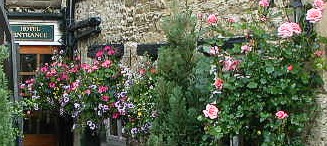From the Ground Up 9
More on Fertilizing
by Derek Burch

We looked in the previous installment at the major elements for plant use supplied in typical fertilizer. Let me begin by repeating the painful truth that no fertilizer at all should be applied without an analysis of the soil that will show what is already there. How can we guess between the virtues of fertilizer with high and low nitrogen, high nitrogen to potassium ratio versus low, and so on, without knowing whether what we put on will improve or worsen the nutrition available to the plant from the soil? No commercial producer could hope to operate effectively without this knowledge.
However, back in our own home gardens, this will remain an ideal that many will not embrace. It does require the effort of finding whether your local university or extension service (or whatever agricultural advisory service exists) offers this service, and then following their instructions precisely for taking the soil samples. They should furnish an explanatory leaflet with the results, and will probably point out any severe problems and what to do about them. Commercial outfits do such an analysis several times during the life of a crop in order get optimum results, home gardeners are ahead of the curve if they do it once in the life of their garden.
In fact, I think that one testing is probably all that most gardens need unless there is a major problem to be solved. If soil nutrients and pH turn out to be in reasonable levels the amount of nutrient to be put into the soil is only the amount equivalent to the plant material that is removed from the garden. A heavily cropped kitchen garden will need more returned to the soil than a flower border, and the more that your garden waste is recycled back into the soil, the less nutrient will have to come from an outside source. Growing trees and other woody plants will tie up (in other words effectively remove) nutrients, but once they reach a certain size will be returning part of what they tied up as leaf litter. Put in other terms, the more of the plant material from your garden that you return to it, the less fertilizer addition you will need to budget. Clean your vegetables of their excess bits into the compost heap, compost all your flower borders and annuals once you clean them up, use a mulch mower on the lawn or bag the clippings and work them into the compost heap, and there will be very little need for fertilizing each year.
Notice that this sort of budgeting is predicated on your soil being in fairly good shape when you start. You cannot take plant remains from a grossly deficient soil, and turn them into rich soil supplements just by passing them through a compost heap. Garbage in, garbage out, if I may borrow from our children or grandchildren.
In real terms, can you get by without worrying about a fertilizer program? You can forget about fertilizing if your soil is rich with a good store of nutrient from having been left alone for a number of years, AND if you are not harvesting from your land, AND if all the plant (and preferably animal) mass that is grown from your land goes back into it. This situation is why rain forests work. You could grow a rainforest on a parking lot or a barracks square if the the climate was right and you could transport a mature forest there in its entirety. Start cutting that forest and burning all that biomass to clear the land to grow crops, and you use up all the stored fertility in few years. Your garden is the same way. If you are based on a living, fertile soil, and nothing leaves the plot, you can go on in good shape indefinitely without opening the first fertilizer sack. Start harvesting a heavy vegetable crop, or sending your grass cuttings or leaves or prunings to the town dump, and you will quite soon find that your soil does not support what it used to, and needs fertilizer added to rebalance the equation.
I know I can't get away without some more definite recommendations. Go on to the second part for some numbers.
Back to Table of Contents